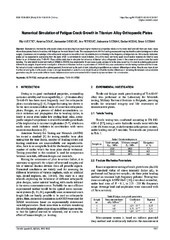Приказ основних података о документу
Numerical Simulation of Fatigue Crack Growth in Titanium Alloy Orthopaedic Plates
| dc.creator | Vučetić, Filip | |
| dc.creator | Čolić, Katarina | |
| dc.creator | Grbović, Aleksandar | |
| dc.creator | Petrović, Ana | |
| dc.creator | Sedmak, Aleksandar | |
| dc.creator | Kozak, Dražan | |
| dc.creator | Sedmak, Simon | |
| dc.date.accessioned | 2022-09-19T19:04:21Z | |
| dc.date.available | 2022-09-19T19:04:21Z | |
| dc.date.issued | 2020 | |
| dc.identifier.issn | 1330-3651 | |
| dc.identifier.uri | https://machinery.mas.bg.ac.rs/handle/123456789/3364 | |
| dc.description.abstract | Biomaterials intended for orthopaedic plates manufacturing have much higher mechanical properties relative to the bone itself and still there are many cases where those plates fracture in service, with fatigue as the main failure mode. This causes problem with the healing process and requires that the patient undergoes another surgery. Experience and knowledge of the orthopaedic surgeon is one of the most important factors contributing to the frequency of fatigue failures. If incorrectly implanted, plates will be subjected to overloading from the start, which is convenient for crack initiation. One of the most commonly used biocompatible materials for internal bone fixation is alpha + beta titanium alloy Ti-6Al-4V. Focus of this study was to simulate the behaviour of titanium alloy orthopaedic plates in the presence of cracks under four-point bending. The extended finite element method (XFEM) in ANSYS was employed for this purpose. Loads correspond to the ones occurring in human tibia during gait cycle for different body weights. Experimental investigation of tensile and fracture mechanics parameters of Ti-6Al-4V alloy was conducted on tensile testing machine and fractomate. Numerical simulation established the optimal geometry from remaining life point of view, indicating large differences between different geometries. Results also have shown that the remaining life of orthopaedic plates is strongly dependant on patients body weight (load) and that the relative differences in remaining life between compared plate geometries stay the same under different loads. Influence of corrosive environment of the human body was not taken into consideration. | en |
| dc.publisher | Univ Osijek, Tech Fac, Slavonski Brod | |
| dc.relation | info:eu-repo/grantAgreement/MESTD/Technological Development (TD or TR)/35040/RS// | |
| dc.rights | openAccess | |
| dc.rights.uri | https://creativecommons.org/licenses/by/4.0/ | |
| dc.source | Tehnički vjesnik | |
| dc.subject | XFEM | en |
| dc.subject | Ti-6Al-4V | en |
| dc.subject | orthopaedic plates | en |
| dc.subject | crack growth | en |
| dc.subject | ASTM F382 | en |
| dc.title | Numerical Simulation of Fatigue Crack Growth in Titanium Alloy Orthopaedic Plates | en |
| dc.type | article | |
| dc.rights.license | BY | |
| dc.citation.epage | 1922 | |
| dc.citation.issue | 6 | |
| dc.citation.other | 27(6): 1917-1922 | |
| dc.citation.rank | M23 | |
| dc.citation.spage | 1917 | |
| dc.citation.volume | 27 | |
| dc.identifier.doi | 10.17559/TV-20200617192027 | |
| dc.identifier.fulltext | http://machinery.mas.bg.ac.rs/bitstream/id/1974/3361.pdf | |
| dc.identifier.scopus | 2-s2.0-85098272584 | |
| dc.identifier.wos | 000600425200026 | |
| dc.type.version | publishedVersion |


